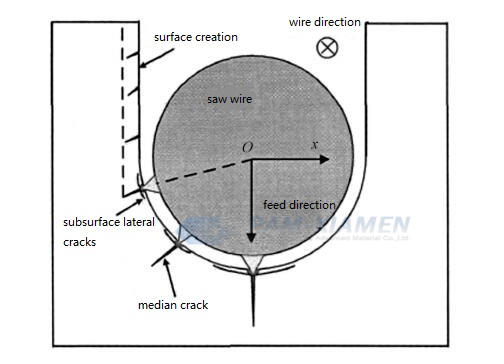Silicon carbide (SiC) wafer are available, for more wafer information please click https://www.powerwaywafer.com/sic-wafer. The performance of SiC wafer slicing determines the processing level of subsequent thinning and polishing. Slicing is prone to cracks on the surface and subsurface of the SiC wafer, increasing the fragmentation rate and manufacturing cost of the wafer. Therefore, controlling the crack damage on the surface of the SiC wafer is of great significance to promote the development of silicon carbide device manufacturing technology.
1. Factors Affecting Quality of SiC Wafer Slicing
The silicon carbide slicing quality is influenced by following factors:
1) The sawing process parameters;
2) The size of the consolidated abrasive particles;
3) The feed movement of the workpiece;
4) The improper control of the saw wire speed.
All the factors may cause surface crack damage to the SiC slice during the wafer slicing process. And surface crack damage is closely related to slice quality. 4H-SiC ingot slicing may produce surface crack damage, which is mainly divided into subsurface lateral crack damage and median crack damage, as shown in Figure below. While the crack damage increases the cost in subsequent processing, it is easy to further expand and cause the SiC wafer to break.

Fig. Surface Crack Damage of Sawing SiC Wafers
Epitaxial growth on silicon carbide substrate, device fabrication process and device performance are all related to crystal orientation. In order to avoid brittle cracks in wafers caused by orientation sensitivity during ingot slicing, crystal orientation detection needs to be performed before slicing silicon carbide ingots.
2. Solutions to Ensure Quality of SiC Wafer Slicing
To ensure the quality of SiC slices, we recommend you the following solutions:
Firstly, SiC ingots are generally grown on the SiC{0001} plane, and cutting along the SiC crystal plane parallel to the growth direction of the ingot can effectively reduce the density of threading screw dislocations on the slice surface and improve the slice quality.
Then, the control of sawing process parameters during slicing is also critical to slicing quality. Reducing the feed rate and feed force can reduce the normal compressive stress of the abrasive grains, increasing the speed of the saw wire can reduce the tangential compressive stress of the abrasive grains, and reducing the wear of the saw wire and the coating and the shedding of the abrasive grains in a small range. However, it is necessary to comprehensively consider the damage degree of the saw wire and the sawing efficiency.
In addition, it is necessary to maintain sufficient and uniform coolant to reduce residual thermal stress, reduce the vibration of the saw wire, and avoid instability of the abrasive stress field.
For more information, please contact us email at victorchan@powerwaywafer.com and powerwaymaterial@gmail.com.

